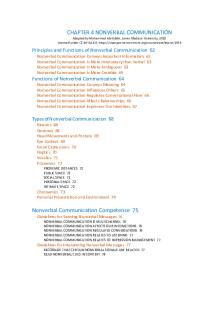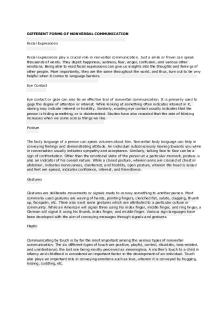Nonverbal Communication Analysis between 2 people Essay PDF

| Title | Nonverbal Communication Analysis between 2 people Essay |
|---|---|
| Course | Interpersonal Communication |
| Institution | Sam Houston State University |
| Pages | 6 |
| File Size | 100.3 KB |
| File Type | |
| Total Downloads | 72 |
| Total Views | 167 |
Summary
Download Nonverbal Communication Analysis between 2 people Essay PDF
Description
Running Head: NONVERBAL COMMUNICATION ANALYSIS
Nonverbal Communication Analysis
1
NONVERBAL COMMUNICATION ANALYSIS
2
Introduction Can you imagine a world without nonverbal cues? What would happen if there are no facial expressions or gestures - just plain words? In this case, communication will be in complete chaos. Nonverbal communication is very important because the interpretation of the meaning of spoken words also depend on the nonverbal cues that are associated as the message is being delivered. For instance, the word “No” spoken with a big smile may have a different interpretation from a “No” that is spoken with a serious face. Moreover, verbal cues, such as a wink, may even express a meaning on its own even without being accompanied by words. In this paper, nonverbal communication of two individuals will be discussed. Specifically, proxemics, kinesics, haptics, and their overall physical appearances will be analyzed to make general assumptions about their relationship with each other and their personalities. The Subjects My observation took place at the Sweet Eugene’s Coffee Shop, which is located at College Station, Texas. It was around 5 o’clock in the afternoon when I stepped inside. I found a table for two where I sat, ready to find my subjects. Among the people inside the shop, two teenage girls caught my attention. They were sitting side by side on the couch, which was about two more tables across where I was sitting. Both of them were around 18 or 19 years old. In this paper, they will be referred to as Girl 1 and Girl 2. With a book and a folder on their table, it is safe to assume that they are students. Proxemics Distance is an important indicator of the type of relationship two people have. At the same time, it is also an important factor in the way they communicate. This is where proxemics comes in. Proxemics is the study of how space is being used during the process of
NONVERBAL COMMUNICATION ANALYSIS
3
communication (Adler, Rosenfeld, & Proctor, 2014). In the case of my two subjects, they clearly share a very close relationship. They were seated on a small couch for two, almost elbow to elbow. With proxemics, this close distance is called intimate zone which is reserved only for close friends and families. Kinesics & Haptics Facial signals, gestures, and body postures are the most well-known forms or nonverbal communication. All of these fall within the area of kinesics. On the other hand, haptics covers nonverbal communication through touching (Adler, Rosenfeld, & Proctor, 2014). I observed a number of these cues as I spent more than 30 minutes observing the two girls. During the first few minutes of observing my subjects, I noticed that they were not talking much. They were just sitting closely with each other. Girl 1 was busy writing something on a small note while Girl 2 was focused on her phone. I was not actually sure if she was browsing the net or going over a reading material, but it took several more minutes before they started to truly interact with each other. Their actual communication that I witnessed started when Girl 2 called the attention of Girl 1. I did not hear if Girl 2 was called by her name but together with a spoken word, Girl 2 also slightly tapped the right leg of Girl 1. With a smile on her face, Girl 2 pointed to her phone screen. She was showing something to Girl 1. Girl 2 also tapped her phone a couple of times while speaking. Both of them started to giggle and laugh, and they continued to talk. I noticed that they were not looking at each other. They were only focused on the phone. After a few seconds, Girl 2 made a small waiving motion using her left hand, as if she was saying “No.” At the same time, Girl 1 started to tap Girl 2’s phone and then she seemed to be pointing at something, just like what Girl 2 initially did. After that, they got their eyes off the phone and they
NONVERBAL COMMUNICATION ANALYSIS started to look at each other while talking. Their body were slightly facing each other. Girl 1 was looking directly at Girl 2’s eyes while the latter was speaking. With her right hand still on the phone, Girl 2 continued to speak while moving her left hand a bit. It looked to me that she was elaborating on something. Then, she made a listing gesture (from 1 to 5) using her fingers. Their smiles never seemed to leave. Also, both of them continued to look at Girl 2’s phone from time to time. At one point, it was Girl 2’s turn to look at Girl 1 while the latter was looking at the phone screen. When their eyes met again, Girl 2 made a small dancing gesture. Girl 1 started to laugh hard while making a light tapping motion on her leg. Their facial expressions varied, including smiling, grinning, laughing, and looking surprise (wide eyes). Now, the kinesics that was observed between the two girls support the implication of the distance that they shares. Because of their close friendship, they looked comfortable with each other. They were not hesitant to establish eye contact. They also seemed to maintain the connection during communication even if there were times when they were talking without looking at each other. Leaning to each other (body posture) as they share the phone screen also showed their closeness. The same is true when Girl 2 allowed Girl 1 to touch and control her phone, which is a personal property. All these are closely related to the way they touch each other. The tapping and the brushing of the arms as they sat and giggled while seated side-by-side all showed that they are very close friends. Physical Appearance Aside from gestures, facial expressions, posture, distance, and touch, one’s physical appearance is also a key factor in communication. Specifically, clothing is also considered as a nonverbal cue. In many cases, people’s appearance provides insights on their personality and background.
4
NONVERBAL COMMUNICATION ANALYSIS
5
Girl 1: She has a medium length blonde hair, which was tied on a half ponytail. She was also wearing a gray long sleeved dress (above the knee) with black sneakers. Although she was wearing make-up, it was very light. Now, wearing a dress and make up highlighted her femininity. At the same time, the colors of her dress (gray) and her sneakers (black) suggest that she is a serious type of student. Although she may not look serious during the observation, she looked like a student who is really interested with studying and learning. Moreover, I consider her sneakers as a sign that she is ready to take action. Overall, she looked like an intelligent student who knows how to keep herself comfortable and in-style at the same time. Girl 2: Compared to Girl 1, Girl 2 looked more like a laid-back type of student. She was wearing a yellow top, ripped jeans, and a yellow Nike running shoes. She looked on-the-go and full of energy. With a yellow top and yellow shoes, it may be assumed that she is not shy or hesitant to get other people’s attention. Her sense of fashion also looked up-to date as suggested by her ripped jeans. In general, her physical appearance suggests confidence and happiness. Conclusion Overall, my observation experience taught me about the importance and scope of nonverbal communication. From what I have observed from my two subjects, I realized that effective communication will not be possible without the use and presence of nonverbal cues. The distance, facial expressions, gestures, body posture, touch, and even the physical appearance all count as nonverbal cues which provide meaning to spoken words. All of these also offer insights to people’s personalities and emotions at the time of communication.
NONVERBAL COMMUNICATION ANALYSIS
6
References Adler, R. B., Rosenfeld, L. B., & Proctor II, R. F. (2014). Interplay: The process of interpersonal communication (13th edition). New York: Oxford University Press....
Similar Free PDFs

6 - Nonverbal Communication
- 1 Pages

Chapter 4 Nonverbal Communication
- 19 Pages

Nonverbal Essay SPC 1017
- 2 Pages

CH 5 HW: Nonverbal Communication
- 2 Pages

Essay 2 - Lens Analysis
- 6 Pages

People express case analysis
- 9 Pages
Popular Institutions
- Tinajero National High School - Annex
- Politeknik Caltex Riau
- Yokohama City University
- SGT University
- University of Al-Qadisiyah
- Divine Word College of Vigan
- Techniek College Rotterdam
- Universidade de Santiago
- Universiti Teknologi MARA Cawangan Johor Kampus Pasir Gudang
- Poltekkes Kemenkes Yogyakarta
- Baguio City National High School
- Colegio san marcos
- preparatoria uno
- Centro de Bachillerato Tecnológico Industrial y de Servicios No. 107
- Dalian Maritime University
- Quang Trung Secondary School
- Colegio Tecnológico en Informática
- Corporación Regional de Educación Superior
- Grupo CEDVA
- Dar Al Uloom University
- Centro de Estudios Preuniversitarios de la Universidad Nacional de Ingeniería
- 上智大学
- Aakash International School, Nuna Majara
- San Felipe Neri Catholic School
- Kang Chiao International School - New Taipei City
- Misamis Occidental National High School
- Institución Educativa Escuela Normal Juan Ladrilleros
- Kolehiyo ng Pantukan
- Batanes State College
- Instituto Continental
- Sekolah Menengah Kejuruan Kesehatan Kaltara (Tarakan)
- Colegio de La Inmaculada Concepcion - Cebu









